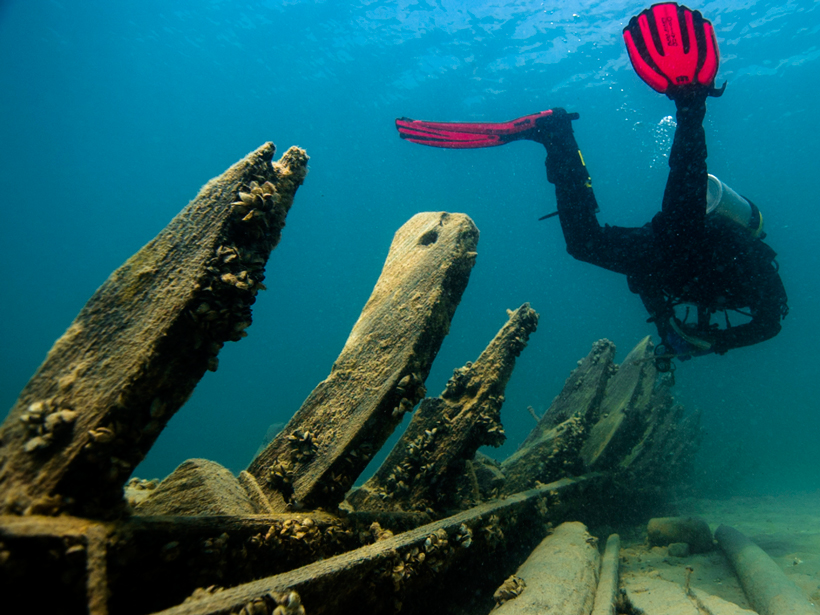A U.S. federal agency is taking a close look at 11 U.S. national marine sanctuaries and national marine monuments that were designated or expanded within the past decade.
The review, which the National Oceanic and Atmospheric Administration (NOAA) began on 26 June, follows a 28 April White House executive order entitled “Implementing an America-First Offshore Energy Strategy.”
The order calls for a reassessment of these nationally significant sites in the oceans and Great Lakes to consider budgetary impacts of managing the areas; the value of potential energy and mineral production in the areas; and the adequacy of federal, community, and other consultations required prior to designations or expansions.
The order also halts new sanctuary designations or expansions unless the proposal includes an accounting from the Department of the Interior of any energy or mineral resource potential within the designated area and the potential impact a designation or expansion would have on resource development.
Some conservationists, however, worry that the review is too narrow in scope and that the administration may be targeting sanctuaries and monuments without fully understanding ecological, cultural, and other values, such as tourism and recreation, that these areas provide.
Hearing Explores Designation and Expansion Process
A 27 June congressional hearing highlighted concerns about designations and expansions of these areas and the need to protect them. The 11 sanctuaries and monuments under review include the Monterey Bay National Marine Sanctuary and others in California, as well as protected areas in Hawaii, American Samoa, Michigan, and elsewhere.

Currently, 13 national marine sanctuaries and two marine national monuments cover about 1 million square kilometers. Eight sites reside in NOAA’s inventory of potential sanctuary designations, with two of those sites—Mallows Bay–Potomac River (Maryland) and Wisconsin–Lake Michigan (Wisconsin)—under consideration for designation.
“While the concept of National Marine Sanctuaries is well intentioned, many of these protected areas have caused some challenges for coastal and Great Lakes communities across the country that are dependent upon the abundant resources found in America’s waters,” said Sen. Dan Sullivan (R-Alaska) at a Senate Commerce, Science, and Transportation subcommittee hearing. Sullivan chairs the Subcommittee on Oceans, Atmosphere, Fisheries, and Coast Guard, which convened the hearing.
Sen. Sullivan charged that the sanctuary designation process “gives NOAA virtually limitless authority to outline the regulations that apply in these sanctuaries.”
Sullivan charged that the sanctuary designation process “gives NOAA virtually limitless authority to outline the regulations that apply in these sanctuaries” and that those regulations “can limit sustainable and economically beneficial commercial and recreational fishing” and usurp the authority of existing management bodies.
Several witnesses at the hearing raised concerns about specific sites. For example, Capt. Scott Hickman, a member of the advisory council of the Flower Garden Banks National Marine Sanctuary offshore of Texas, complained about a proposed expansion of that sanctuary. He said that NOAA staff recommended a much larger expansion than did the advisory council. “Currently, the way the act is, our voice doesn’t have a weight,” said Hickman, owner of Circle H Outfitters and Charters in League City, Texas. “We can recommend something but then they can do something totally different.”
Economic, Ecological, and Other Benefits
“The economic boom has been tremendous in my state” with the Thunder Bay National Marine Sanctuary.
The subcommittee’s ranking Democratic member, Sen. Gary Peters (D-Mich.), defended marine sanctuaries and monuments. “The economic boom has been tremendous in my state,” with tourism and other activities associated with the Thunder Bay National Marine Sanctuary helping the local economy, he said. The sanctuary “serves as an educational and historical treasure that preserves 110 known shipwrecks that document over 200 years of maritime history,” Peters added.
Conrad Lautenbacher, who was the NOAA administrator in the George W. Bush administration, testified that protected ocean areas generate about $8 billion annually from activities such as tourism and recreation that are compatible with maintaining protection of the area. Sanctuaries, he added, “play a major role in stemming this decline [in ocean health] and with increased support can play a major role in actually reversing the downward trend.” He said the designation process is very thorough, but “it doesn’t mean it can’t be corrected or changed.”
A Call for Continued Bipartisan Support
The National Marine Sanctuary Foundation, a national nonprofit based in Silver Spring, Md., opposes potential revocation or weakening of designations and expansions and has urged people to submit written comments, which NOAA is accepting until 26 July. In written testimony submitted for the hearing, Kristen Sarri, the foundation’s president and chief executive officer, called marine sanctuaries “national treasures” that provide a wide range of benefits, including resource conservation, public access, preservation of maritime heritage, opportunities for scientific research, and strengthening of the nation’s economy.
Sarri said she is “very hopeful that we will be able to continue to work with the Trump administration and they will be able to see the benefits of this type of conservation effort.”
In an interview with Eos, Sarri acknowledged that there is room for improvement in some designation and expansion efforts and said that NOAA needs sufficient resources to support community engagement.
She stressed the bipartisan support for marine protected areas during the Obama and George W. Bush administrations. “I am very hopeful that we will be able to continue to work with the Trump administration and they will be able to see the benefits of this type of conservation effort in our oceans and Great Lakes,” Sarri said.
Partisanship, she added, should not interfere with protecting marine sanctuaries and monuments. Rather, policies regarding these protected areas “really should be about what’s in the best interests of the American people.”
—Randy Showstack (@RandyShowstack), Staff Writer
Citation:
Showstack, R. (2017), Trump administration scrutinizing protected ocean areas, Eos, 98, https://doi.org/10.1029/2017EO077497. Published on 06 July 2017.
Text © 2017. The authors. CC BY-NC-ND 3.0
Except where otherwise noted, images are subject to copyright. Any reuse without express permission from the copyright owner is prohibited.

